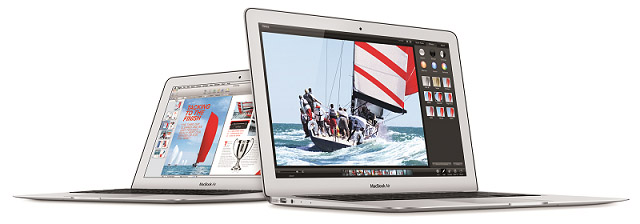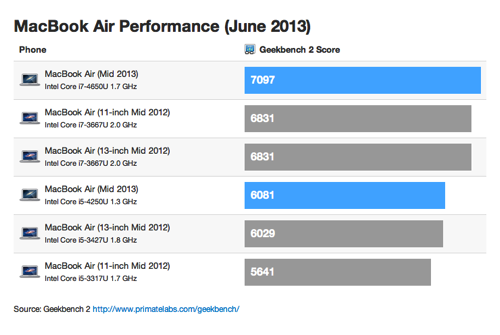The brand new MacBook Air for the year 2013 is now available in a form of four SKUs: the 11.6-inch MD711LL/A and MD712LL/A, and 13-inch MD760LL/A and MD761LL/A. Let’s take a look at highlights of the whole new lineup of Apple’s popular ultraportables and the main differences between the models, as well as the first benchmark results of computing speed and (shocking) battery life.

The stars of the show are new processors in form of the latest generation Intel “Haswell” chips. Bu default, all of the models, the MD711LL/A, MD712LL/A, MD760LL/A, and MD761LL/A, come with an Intel Core i5 clocked at power-saving 1.3GHz on default, with possibility to run at up to 2.6GHz if needed to complete a task quicker. For users needing more computing muscle, Apple has provided an option to upgrade the CPUs to the Intel Core i7 1.7GHz dual-core, with the upper clock rate limit of 3.3GHz.
There’s another CPU-related refresh worth noting. The on-CPU integrated graphics is now the Intel HD 5000, replacing the old HD 4000 found in the previous-generation MacBooks. Intel says the new IGP is up to 50 faster than the older counterpart.
Regarding visuals, it’s important to know that, besides length of LCD diagonals, there’s a difference is in screen resolutions. The smaller MacBook Air is at 1,366×768 pixels, while the larger one has a pixel count of 1440×900.
The main difference between the models with the same screen size is in available internal storage. The 11″ MD711LL/A has solid state drive with a capacity of 128GB, whereas the 11″ MD712LL/A sports double that amount or 256GB. The same applies to the 13″ MD760LL/A and MD761LL/A with 128 and 256 GB, respectively.
You will hardly ever need more than included 4GB of RAM, but Apple has provided its customers with a choice to get 8GB.
On the design front, nothing has changed. We still have the legendary extra-sleek aluminum cases with profiles ranging from only 0.11″ at the thinnest point to 0.68″ at the thickest. The smaller models weigh 2.38 pounds, whereas the bigger measures a shade less than 3 pounds or 2.96lbs more precisely.
Besides the screen, the most important part of the notebook externally is the keyboard and the same old backlit chiclet style one remained on the new models. Other features include two USB 3.0 ports, Thunderbolt port, support for the latest-gen 802.11ac Wi-Fi standard, Bluetooth 4.0, FaceTime HD webcam, and stereo speakers, as well as an SDXC memory card slot on the 13″ model.
When it comes to pricing, the 128GB 11.6-incher is $999, while the 256GB version is $1,199. The respective 13.3” models are $100 more expensive, which is really a tiny difference if you consider the bigger and higher-res screen and longer battery life. Regarding prices of component upgrades, stepping up to the Intel i7 CPU will cost you $150, while going from the 256GB to 512GB SSD will add $300 to the overall price. RAM upgrade to 8GB is $100.
Benchmarks and Battery Life
GeekBench benchmark suite is pretty much accurate when calculating processor speed and the first results show a modest advantage of the Haswell CPUs inside the new MacBook Airs over the older “Ivy Bridge” in the 2012 edition. Speed increase is between only 3 and 8 percent, depending on model.

Laptop Mag was one of the first blogs with a published review of the 13.3-incher, but reviews of its smaller sibling are nowhere to be found. In terms of graphics muscle, the magazine concluded that the newer Air is about twice as fast in OpenGL benchmark than the previous generation and that the notebook can be used for smooth gameplay of the World of Warcraft game on “Good” detail settings and 1300×812 resolution.
Other than boosted CPU/GPU performance, “Haswell” brings to the MacBook Airs, and to Windows laptops as well, a better power efficiency. Apple claims the new 11.6″ and 13.3″ models deliver a battery life of up to 9 and 12 hours respectively in light use or up to 8 and 10 hours respectively when playing iTunes movies. Regardless of screen sizes, the standby time is up to whooping 30 days.
Engadget’s test of the 13-incher revealed that the battery life lasts stunning 12 hours and 51 minutes, about double the battery life of the previous model and those achieved with comparable Windows ultrabooks. Laptop Mag’s real-world battery test involving web surfing via Wi-Fi registered a result of still whooping 10 hours and 53 minutes.
Also worth noting is greatly improved I/O speed of the embedded solid state storage, which is faster even than on the high-end Retina MacBook Pro, according to Engadget.
Overall, the new MacBook Air appears to be a good investment for those who have the means to pay $1,000 or more for a new notebook, especially those who spend a lot of time on the road or want to end a working day without recharging the laptop.
